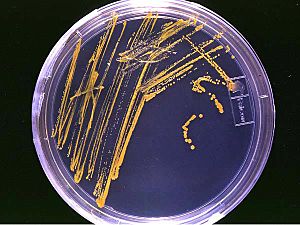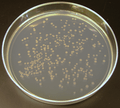Agar plate facts for kids
An agar plate is a special dish used in science. It is a Petri dish that holds a jelly-like substance called agar. This agar also contains nutrients, which are like food for very tiny living things. Scientists use agar plates to grow and study these tiny living things, called microorganisms.
For example, if someone is sick, a doctor might take a small sample, like blood. This sample can be put on an agar plate. If there are bacteria making the person sick, they will grow on the plate. Scientists can then look at these bacteria with a microscope. This helps doctors figure out the best way to treat the patient.
What Are Colonies?
When microorganisms grow on an agar plate, they often form small, visible clumps. These clumps are called colonies. Each colony usually starts from just one microorganism. This means all the tiny living things in one colony are very similar to each other. They have the same genetic features.
Different Kinds of Agar Plates
There are many types of agar plates used in science. The two main types are called "defined" and "undefined."
- Undefined plates: These plates have nutrients, but scientists don't know the exact amount of each nutrient. It's like a general meal for the microorganisms.
- Defined plates: For these plates, scientists know exactly what nutrients are in them and how much of each. This is useful when they need very precise results.
Related pages
Images for kids
-
An agar culture of E. coli colonies
-
Red blood cells on an agar plate are used to diagnose infection. On the left is a positive Staphylococcus infection, on the right a positive Streptococcus culture.
-
Hemolyses of Streptococcus spp. (left) α-hemolysis (S. mitis); (middle) β-hemolysis (S. pyogenes); (right) γ-hemolysis (= nonhemolytic, S. salivarius)
-
Four types of agar plate demonstrating differential growth depending on bacterial metabolism
See also
 In Spanish: Placa de agar para niños
In Spanish: Placa de agar para niños











